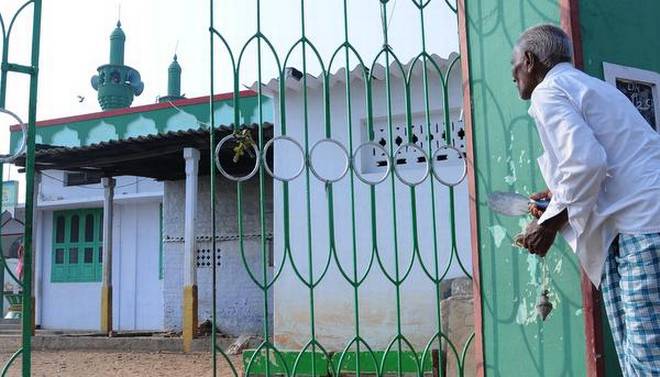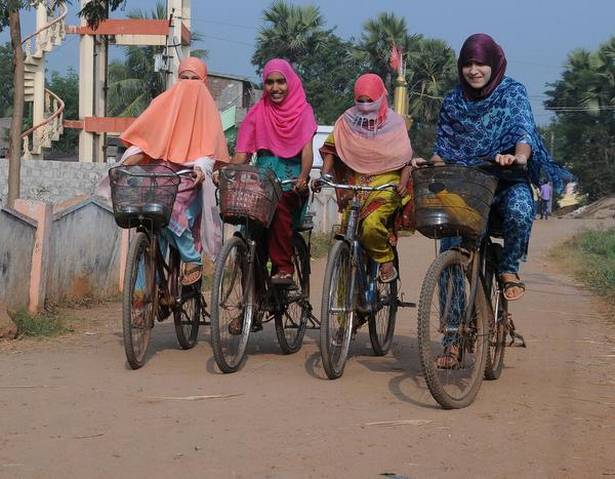Alinaqipalem, ANDHRA PRADESH :

A village in Andhra Pradesh where every family is Shia and everyone is a mason
Every day before the sun rises, almost all the villagers of Alinaqipalem in Andhra Pradesh’s Krishna district set off for work with their lunch boxes and tool kits. Work could take them to Vijayawada, Challapalli or Machilipatnam, where they will lay stone and cement for homes and buildings all day and return home by sundown. They have been doing this for generations now, for Alinaqipalem is a mason’s village, with almost all the 450-odd families here involved in construction work. In fact, till a few years ago they were all masons without exception, but slowly they are beginning to take up other professions.
The remote and idyllic Alinaqipalem has another distinction — the village has only Shia families. Surrounding villages call it ‘Turakapalem’ or the village of Muslims.
According to oral history, Abul Hasan Qutb Shah or Tani Shah, ruler of Golconda and the last of the Qutb Shahi dynasty, invited Mullah Mohammed Ali from Isfahan in Iran to come to India to teach his children. This was some 330 years ago. The mullah’s eldest son Haider Ali Naqi Isfahani and two families later settled down in this part of Krishna. They were soon followed by more families and a small hub of Shias emerged gradually. The village derives its name from the first settler and is called Alinaqipalem or Ali Naqi’s village.
Over the years, the villagers married local people, lost their Iranian features and forgot their mother tongue. Today, no one understands or speaks Persian or Arabic, except the two imams who offer prayers at the village’s two masjids. Both men are in their mid-40s and they went to Isfahan and Najafi, respectively, for their training.
The villagers speak Urdu, liberally laced with Telugu. Nothing of Iran remains, either architecturally or culturally: they have neither the multi-storeyed buildings made of red clay as in Iran’s Abyaneh village nor the yellow clay-coated buildings of Masouleh. The only thing remotely Iranian are the occasional posters of Ayatollah Khomeini that I came across every now and then on the walls. “Khomeini is our religious leader. So the photographs,” said Mirza Mohammed Ali, 69, a village politician.

Most of the villagers I spoke to didn’t remember how and when masonry became the village’s chief occupation. And then I found 57-year-old Mirza Javad Hussain, headmaster of the local school. We sat in the balcony of his neat, double-storied building covered with printed tiles and he told me the story of how some 120 years ago, one Azgar Ali from Pedana village, not so far away, introduced masonry work here.
“Until then,” said the bespectacled and bearded Hussain, “the villagers here worked as carpenters and ironsmiths.” Hussain is one of the few villagers with a modern connection to the Middle East — he was one of five persons from India to go to Baghdad in 2013 to participate in Jashn-e-Sabr-o-Wafa, the birthday celebrations of Imam Hussain, the grandson of the Prophet.
Mohammed Abbas is 22 and a mason. He dropped out of school as a teen. Ali Haider, who taught him in school, remembers him as “enthusiastic and eager to learn new things.” But Abbas is happy with his lot. “My grandfather used to be taapi maestri (mason). So was my father and now I am one too,” he said with a laugh. Others have been more ambitious. About 60 to 70 of his peers have gone off to West Asia to work on building sites.
***
According to revenue records, Alinaqipalem is really only a hamlet within Choragudi village. The families here don’t own any land and don’t farm. A couple of small shops stock all their needs. Mantada, 15 km away, is their closest transit hub. They take a share auto or bus from the Alinaqipalem junction to get there. The roads are not great and the bus services infrequent.
The nearest government health centre is at Veerankilakulu, 7 km away, and pregnant women are rushed to Uyyur, 22 km away, for an obstetrician. For everyday illnesses, there’s a registered medical practitioner who visits every day.
Sarpanch Ali Akbar says Alinaqipalem has been neglected. “We are trying to develop the village with available funds.” He complained about wanting a Shia qazi and is proud that the mosques were not handed to the Wakf Board but are managed by the villagers.
Alinaqipalem looks reasonably prosperous. Almost all the houses are brick and mortar (with cement bags as window curtains!) and there are only a handful of thatched roofs in sight. Those who can afford it, engrave their doors with quotes from the Koran. Every home has a television while some also have air-conditioners and two-wheelers. The headmaster has a car, and many homes have grapevines and flowering shrubs. The two mosques are well maintained, each with a pond stocked with fish. Each year, fishing rights are auctioned and the funds go to the mosque. Every villager pays Rs. 200 for the imams’ upkeep.
The newer mosque is shaped like an old three-paisa coin, a hexagon that fits the dimensions of the land available. Indeed, villagers now call it the ‘three-paisa mosque’. “The design was approved as the Qibla is the direction that should be faced during Salah prayers,” said Ali.
The Islam preached here is moderate and modern. The imams ban neither Western dress nor television. “Without television and knowledge of the outside world, they will remain ignorant,” said the imam, Mirza Ibrahim Ali Isfehani, “But I ask them to avoid serials and focus on the news.”
Elderly men wear dhotis and a local adaptation of the kurta, but the younger generation is in jeans or trousers. Women wear saris and don headscarves when they venture outdoors and cross the road when men walk by.
Ali Isfehani himself is resplendent in a long, white thobe flowing from shoulders to ankles, an imamah or white turban wrapped flat on his head, and the aba, a black, sleeveless, open cloak that is mandatory for an imam. As he spoke to us, couplets or noha in praise of Imam Hussain wafted from his tape recorder. Two steel cupboards were lined with religious texts, a few rosaries and phials of ittar.
Even though most of the villagers are school dropouts, they appear to have imbibed some progressive thinking from the mosques. “We are even advised informally to practise family planning,” said Ali. And long before the government came up with the Dulhan scheme, the villagers had drawn up their own plan. Elders and religious heads convene a meeting when a marriage is arranged in the village and everyone makes a contribution to the girl’s family towards wedding costs. In fact, in recent years, girls have completed schooling and a few are employed as teachers in neighbouring villages.
Alinaqipalem is a tiny bit of Iran that has now become completely Indian, whether in clothes, customs or even the villagers’ facial features. Sadly, not a trace remains of Iranian cuisine, with the only giveaway being the rotis the villagers eat a couple of times a week.
Soon, it might cease to be a mason’s village too. Already, a few of the younger men have studied engineering and medicine and are working in countries like Canada. Some have become teachers, some have joined the police. For the time being, however, masonry remains their mainstay. I asked Abbas if, given a chance, he would resume studies. He smiled shyly and said, “I get Rs. 400 to Rs. 500 a day now. What job will fetch me this kind of money?”
subbarao.gavaravarapu @thehindu.co.in
source: http://www.thehindu.com / The Hindu / Home> Society> Cover Society / by G.V. Subba Rao / January 20th, 2017








